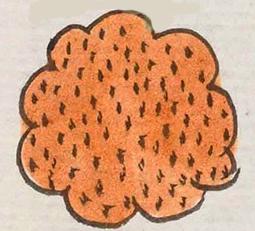atoctli (Mdz29r)
This element has been carved from the compound glyph for the place name Atocpan. The fertile soil (atoctli) of this glyph takes a circular shape, colored orange-terracotta, with scalloped edges, and the uniform paint of the inner region of the circle is dotted with black ink.
Stephanie Wood
The color of paint used for this soil is about the same as what was typically used in this manuscript for soil, pottery, and wood. The black dots are suggestive of sand (xalli), small stones mixed in the soil, or seeds that have been planted. The scalloped edges of the circular shape for this sign give the impression of a cloud of dust, but humid soil would not likely take that form. This humidity is flagged by the "a" (from atl, water) at the start of the word. The second syllable (-toc) may come from the verb to plant (toca). The fertility of this soil is also underscored in the original, full, compound glyph (see our attestation in this record), by the maize plant growing out of the soil, with two ears of corn, one red and one yellow, five leaves, and a yellow blossom at the top.
Stephanie Wood
c. 1541, but by 1553 at the latest
Stephanie Wood
soils, irrigation, farming

atoc(tli), thick, fertile, humid soil, https://nahuatl.wired-humanities.org/content/atoctli
a(tl), water, https://nahuatl.wired-humanities.org/content/atl
toca, to plant, https://nahuatl.wired-humanities.org/content/toca
thick, fertile, humid soil
tierra gruesa humida y fertil
Stephanie Wood
Codex Mendoza, folio 29 recto, https://digital.bodleian.ox.ac.uk/objects/2fea788e-2aa2-4f08-b6d9-648c00..., image 68 of 188.
The Bodleian Libraries, University of Oxford, hold the original manuscript, the MS. Arch. Selden. A. 1. This image is published here under the UK Creative Commons, “Attribution-NonCommercial-ShareAlike 3.0 License” (CC-BY-NC-SA 3.0).
